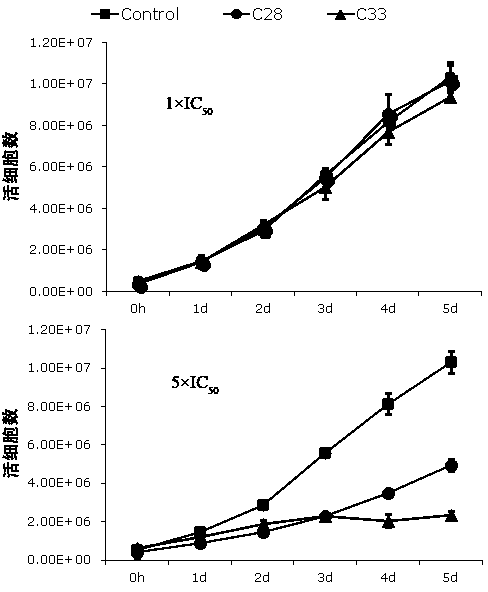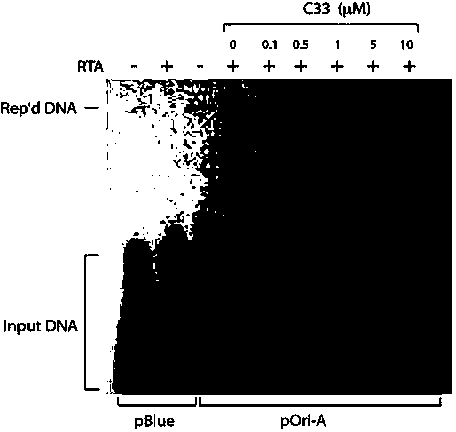Application of benzo Alpha-pyrone compound as Gamma-type human herpes virus-resistant medicine
A human herpes virus and compound technology, applied in the treatment of diseases related to γ-type human herpes virus infection, in the field of benzo α-pyrone compounds, can solve the problems of lack of cleavage and replication, and achieve high incidence of KS, Easy to synthesize and reduce the incidence of disease
- Summary
- Abstract
- Description
- Claims
- Application Information
AI Technical Summary
Problems solved by technology
Method used
Image
Examples
Embodiment 1
[0042] Example 1: Virtual screening of compounds
[0043] 1. Compound library preprocessing: The virtual screening compound library is a self-prepared compound database. The compound library is processed as follows: removing ions and complexing water molecules, adding charges, protonating, and generating three-dimensional conformations. These processes are completed in the drug design software package Discovery Studio2.5. The protonation is carried out at pH6.5-8.5. Prepare small molecule libraries for virtual screening.
[0044] 2. Search the database for substructure matching based on the benzoα-pyrone structure to find compounds containing the parent nucleus. Finally, 7 compounds (C18, C19, C28, C30, C33, C34, C35) were selected for cytological experiments. The chemical structures of the compounds are shown in Table 1.
Embodiment 2
[0045] Example 2: Determination of KSHV split replication inhibitory activity
[0046] 1. Cell culture. BCBL-1 cells (primary effusion lymphoma cell line, containing latent KSHV) were cultured in vitro. The RPMI1640 medium containing 10% fetal bovine serum was used for routine maintenance and passage at 37°C and 5% carbon dioxide concentration.
[0047] 2. Drug intervention. Adjust the logarithmic growth phase BCBL-1 cell density to 3×10 5 cells / ml, use 20ng / ml Tetradecanoyl phorbol acetate (TPA) to induce BCBL-1 cells to enter the lytic replication phase. The compounds to be tested were formulated as drug solutions with different concentrations using DMSO. After BCBL-1 cells were treated with TPA for 3 hours, the cells were treated with different concentrations of compounds (the above 7 compounds), and three parallel wells were set up for each concentration, and a control group without TPA induction and without compound treatment was set up Compare.
[0048] 3. Test met...
Embodiment 3
[0052] Example 3 Inhibition of KSHV Virus Particle Release Experiment
[0053] 1. Cell culture. BCBL-1 cells were cultured in vitro. Use RPMI1640 medium containing 10% fetal bovine serum, 100 U / ml penicillin, and 100 μg / ml streptomycin for routine maintenance and passage at 37°C and 5% carbon dioxide concentration.
[0054] 2. Drug intervention. Adjust the logarithmic growth phase BCBL-1 cell density to 3×10 5 cells / ml, use 20ng / ml TPA to induce BCBL-1 cells to enter the lytic replication phase. The compounds to be tested were prepared in different concentrations using DMSO. After BCBL-1 cells were treated with TPA for 3 hours, the cells were treated with different concentrations of compounds (the above 7 compounds), and three parallel wells were set up for each concentration, and a control group without compound treatment and without TPA induction was set up Compare.
[0055] 3. Test method. After the cells were treated with TPA for 5 days, the cell culture solution wa...
PUM
 Login to View More
Login to View More Abstract
Description
Claims
Application Information
 Login to View More
Login to View More - R&D
- Intellectual Property
- Life Sciences
- Materials
- Tech Scout
- Unparalleled Data Quality
- Higher Quality Content
- 60% Fewer Hallucinations
Browse by: Latest US Patents, China's latest patents, Technical Efficacy Thesaurus, Application Domain, Technology Topic, Popular Technical Reports.
© 2025 PatSnap. All rights reserved.Legal|Privacy policy|Modern Slavery Act Transparency Statement|Sitemap|About US| Contact US: help@patsnap.com



